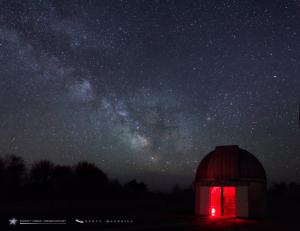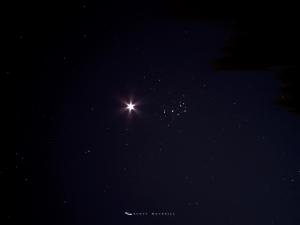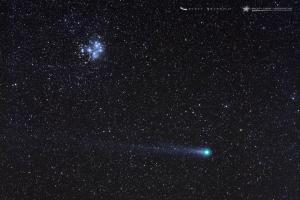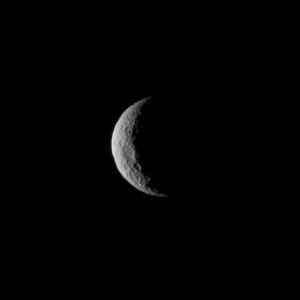
Public Stargazing
- Where:
- Frosty Drew Observatory
- When:
- Friday April 10, 2015 at 7:00 p.m. - 9:00 p.m.
- Cost:
- $1 Suggested Donation per Person
Tonight's weather, again, is calling for clouds, rain, wind, fog, and possibly a t-storm. This is our fourth Friday in a row of dismal weather with little to no hope of a celestial view. The weather should clear out over night, though probably too late to open the telescopes. The near third quarter Moon will rise around 1:20 a.m. and possibly offer up some excellent views of the lunar western hemisphere, depending on weather. The Moon will continue to wane this week as we move towards its new phase next weekend. Though skies are in fail mode tonight, if weather permits, next weekend's starscape will rock!
We plan to open the Sky Theatre from 7:00 p.m. - 9:00 p.m. tonight with a slide show of astrophotos shot at Frosty Drew Observatory and an open discussion on general astronomy. In the Observatory, tours of our telescopes will be available to further intensify our dismay at not being able to observe through them. These are the nights to geek out with the gear that would normally be difficult to see with the lights off. If skies clear earlier, maybe we can sneak a peek of a few binary stars.
Overall, the forecast lately has been pretty tough on Friday nights. Though spring is our best season at Frosty Drew and the Moon is moving into an excellent period of dark sky friendly phases. As clear nights come, step outside and catch a view of the fabulous spring constellations coming into prime time viewing. Perhaps grab a glimpse of the International Space Station passing over or a quick binocular view of Venus, Jupiter and the four Galilean Moons, or the bright M44 beehive open star cluster just to the right of Jupiter in the constellation Cancer. Regardless, get out there and make a time of the clear skies that are a rarity in New England spring.
-------------------------------------------------------------------------
Weekly Happenings
Scott MacNeill
This weekend a yet again fantastic conjunction that includes Venus is happening. Tonight (Friday), Saturday, and Sunday; just after sunset, Venus will be within a couple degrees of the Pleiades open star cluster. These two celestial objects will offer a nice contrast considering Venus is crazy bright and the Pleiades is rather dim comparatively.
The Pleiades, which is so well known among even the most basic of sky watchers, is found in the constellation Taurus and is considered a harbinger of the onslaught of winter when it becomes visible in the autumn night time sky. Carrying the designation “Messier 45”, the Pleiades resembles a very small dipper. This resemblance has often resulted in casual sky watchers mistaking the Pleiades for the Little Dipper. Though appearing like a constellation, the Pleiades is actually an open star cluster residing at a mere 444 light years distant. As far as open star clusters go, this is quite close, so close that it qualifies the Pleiades as the third closest open star cluster to Earth!
Open star clusters are a grouping of a few thousand stars that are all bound together by each others gravity. Stars in open clusters form from the same molecular cloud making then all approximately the same, relatively young, age. When looking at the Pleiades naked eye we see about seven individual stars. Though these seven stars are the most massive and brightest stars in the cluster and were largely responsible for the transition from a star forming nebula (like the Orion Nebula), to an open star cluster. As the Pleiades interacts with nebulae and other gravitational forces in the galaxy, component stars will leave the cluster and become independent star systems.
Observing the conjunction of Venus and Pleiades will be super easy. Just look for the massively bright star-like object in the western sky after sunset, that's Venus. Each night this weekend, the Pleiades will appear to move a little further past Venus towards the horizon. Though tonight's skies will fail miserably, Saturday and Sunday are setting us up for a killer view. So grab a friend, partner, the kids, or just your trusty binoculars and step out for a mesmerizing twilight view of these two stunning objects performing their celestial dance. If you happen to snap a picture of the conjunction, be sure to post it on the Frosty Drew Observatory Facebook page and we will share it on our time line.
Remember that unbelievably awesome little spacecraft that acquired orbit around the closest dwarf planet to Earth this past March? Well if you missed out, it's the NASA Dawn mission and its new place of residence is the dwarf planet, Ceres. News feeds from Ceres has been rather quiet these past few weeks as the Dawn spacecraft performs orbital maneuvers, descending to a much closer altitude. But that silence is about to change as the next incoming wave of Ceres awesome is about to happen when new images of the dwarf planet, taken today and again on Tuesday (April 14th), start to come home.
Shortly after acquiring orbit around Ceres on March 6th, Dawn's momentum projected the spacecraft to quite a high altitude of about 46,800 miles on March 18th. Since then, Dawn has been closing in on its first planned science orbit altitude of 8,400 miles, which it will attain on April 23rd. As of this writing, Dawn is about 26,000 miles out and will be at this altitude when snapping new photos over the next several days.
Photos this week will be shot from the shadow side of Ceres and will show the dwarf planet in a crescent phase. Though these images will likely be the best images to date (woot!), the best are totally to come. By the time early May swings around, Dawn will be well into its intensive prime science campaign. Images at that time will significantly improve our view of the entire surface of Ceres and help further identify the mysterious bright spots on Ceres that are reflecting a significantly higher amount of light than their surroundings. These bright regions have been the topic of intense speculation and higher resolution images will be in high demand. Keep up with incoming images from the Dawn mission and get ready for amazing discoveries just around the corner as we perform our first up-close study of a dwarf planet.
-Scott




